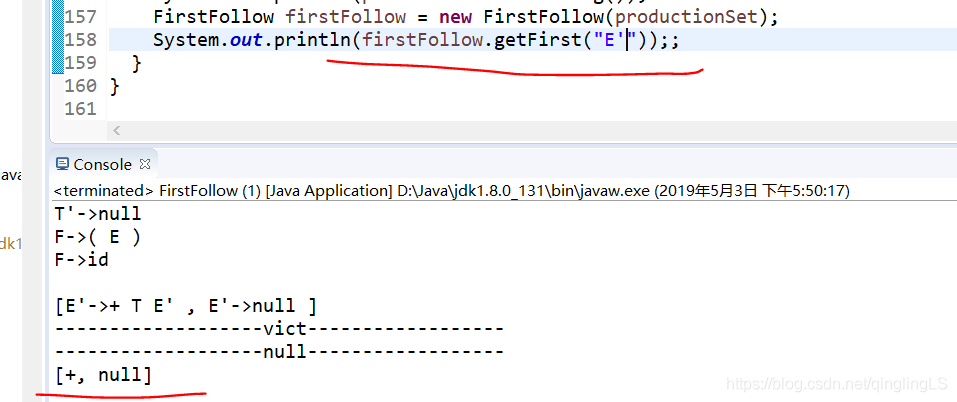版权声明:本文为博主原创文章,未经博主允许不得转载。如果你非要转载,麻烦加上我的原网址,谢谢。http://blog.csdn.net/qinglingLS https://blog.csdn.net/qinglingLS/article/details/89789739
哈哈,经历了千辛万苦,我!终于!写出来了!
其实总体说来也不难,但是我比较傻,想来想去都想不通,现在终于写出来了,请大家分享一下我的快乐~~~~~~哈哈哈!!
下面是这部分的代码,我贴一部分,剩下的等我把求follow集实现再写一篇博文来给大家看!
请给我点赞谢谢~!!!
实现得非常简洁明了(自夸)
你可以看下注释,写的非常清楚啦!!!
package parse2;
import java.util.ArrayList;
import java.util.Iterator;
import java.util.List;
import parse2.Production;
public class FirstFollow {
List<Production> proList = new ArrayList<Production>();
public FirstFollow(ProductionList productionList) {
proList = productionList.getProductions();
}
/**
* 判断是不是终结符,如果左边没这个作为开头的,那就是终结符了。
* @param str
* @return
*/
public boolean isVariable(String str) {
for (Iterator<Production> iterator = proList.iterator(); iterator
.hasNext();) {
Production production = (Production) iterator.next();
if (production.getLeft().equals(str)) {
// 一旦找到左边有等于str的字符,就说明str不算终结符,返回真:是变量
return true;
}
}
return false;
}
/**
* 判断是不是空产生式集
* @param str
* @return
*/
public boolean isEmpty(String str) {
for (Iterator<Production> iterator = proList.iterator(); iterator
.hasNext();) {
Production production = (Production) iterator.next();
if (production.getLeft().equals(str)) {
for (int i = 0; i < production.getRight().length; i++) {
// System.out.println(production.getRight()[i]);
if (production.getRight()[i].equals("null")) {
return true;
}
}
}
}
return false;
}
/**
* 返回包含这个左部的产生式集合,
* @param B
* @param productions
* @return
*/
public List<Production> findLeft(String B) {
List<Production> list = new ArrayList<>();
for (Iterator<Production> iterator = proList.iterator(); iterator
.hasNext();) {
Production production = (Production) iterator.next();
// System.out.println(production.getLeft());
if (production.getLeft().equals(B)) {
list.add(production);
}
}
return list;
}
/**
* 获取非终结符号的产生式的first集合X->Y1Y2Y3Y4Y5……这样的,
* @param str X
* @return
*/
public List<String> getFirstItem(Production production) {
List<String> list = new ArrayList<>();// 获取包含这个str左部的产生式
// 遍历这个产生式的每一项,其中每个产生式的每一项也需要遍历。
for (int i = 0; i < production.getRight().length; i++) {
if (!production.getLeft().equals(production.getRight()[i])) {
list.addAll(getFirst(production.getRight()[i]));
System.out.println(production.getRight()[i]);
} // 没有左递归
if (!isEmpty(production.getRight()[i])) {
// 这个项里没有包含空产生式的话,就继续求解,否则结束。
return list;
}
}
/* List<Production> findList = findLeft(str);
for (Iterator<Production> iterator = findList.iterator(); iterator
.hasNext();) {
Production production = (Production) iterator.next();
for (int i = 0; i < production.getRight().length; i++) {
System.out.println(production.getRight()[i]);
list.addAll(getFirst(production.getRight()[i]));
if (!isEmpty(production.getRight()[i])) {
return list;
}
}
}*/
return list;
}
/**
* 判断是不是空产生式集
* @param strings
* @return
*/
public boolean isEmpty(String[] strings) {
for (int i = 0; i < strings.length; i++) {
if (strings[i].equals("null")) {
return true;
}
}
return false;
}
/**
* 获取first集合
* @param str
* @return
*/
public List<String> getFirst(String str) {
List<String> list = new ArrayList<>();
List<Production> productions = findLeft(str);
System.out.println(productions);
for (Iterator<Production> iterator = productions.iterator(); iterator
.hasNext();) {
Production production = (Production) iterator.next();
if (isEmpty(production.getRight())) {
System.out.println("-------------------null------------------");
// 检查X->null是否成立
list.add("null");
} else if (!isVariable(production.getRight()[0])
&& !isEmpty(production.getRight())) {
// 是终结符的话就直接加入。
System.out.println("-------------------vict------------------");
list.add(production.getRight()[0]);
} else {
System.out.println("-------------------set------------------");
list.addAll(getFirstItem(production));
}
}
return list;
}
public static void main(String[] args) {
ProductionList productionSet = new ProductionList();
System.out.println(productionSet.toString());
FirstFollow firstFollow = new FirstFollow(productionSet);
System.out.println(firstFollow.getFirst("T'"));;
}
}
效果示意:
我用的产生式如下:
龙书(紫色第二版)P140的例子文法,当然其他的文法也不在话下~~
另外注意,左递归不消除的话可能会导致循环哦!!!
E -> T E'
E' -> + T E'|null
T -> F T'
T' -> * F T'|null
F -> ( E )|id
代码运行结果:这里的null表示空~!



现在的心情非常激动~~!